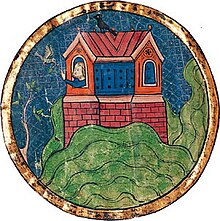아라랏 산맥
Mountains of Ararat창세기에서 아라라트 산(성경 히브리어) 노아의 방주가 대홍수 이후 잠들어 있는 지역을 가리키는 용어이다.그것은 아르메니아 반 왕국의 옛 이름인 고대 아시리아어 우라르투에 해당된다.아라라트 산맥은 오늘날의 터키에 위치해 있습니다.
중세 이후 "아라랏 산"은 현재의 터키(역사적 아르메니아)의 마시스 또는 아뢰르 다이로 알려진 산과 동일시되기 시작했고, 이 [2][3]산은 아라랏 산이라고 알려지게 되었다.
역사
역사학자 베로수스, 이집트인 히에로니무스, 므나세아스, 다마스쿠스의 니콜라우스를 인용하면서 요세푸스는 그의 유대인 유물에 "그의 방주는 [4]바리스라고 불리는 아르메니아에 있는 어떤 산의 꼭대기에서 쉬었다"고 쓰고 있다.
마찬가지로 라틴어 벌게이트에서는 제롬이 창세기 8장 4절을 "requievitque arca... super montes Armene" ("그리고 방주는 아르메니아 산 위에 놓여있다")[5]로 번역한다; 제2차 바티칸 평의회 이후 발표된 노바 벌가타에서는 지명이 "아르마산" ("Armountains")으로 수정된다.
이와는 대조적으로, 초기 시리아와 동양의 전통은 이 방주를 오늘날 남동 아나톨리아 지역의 [7]시르나크 주에 있는 주디 산에 놓았는데, 이것은 중세에 의해 퇴색되어 지금은 대부분 코란 [citation needed]전통에 한정되어 있다.
쥬빌레에는 그 방주가 [8]아라라트 산인 루바르 봉우리에 잠들어 있었다고 명시되어 있다.
월터 롤리 경은 그의 세계사(1614)의 여러 장을 고대에는 아라라트 산이 아르메니아 산뿐 아니라 아시아로 뻗어나가는 모든 높은 산맥을 포함하는 것으로 이해되었다는 주장에 할애하고 있다.그는 아르메니아가 실제로 시나르 [note 1]동쪽에 위치해 있지 않기 때문에 방주가 [citation needed]동양 어딘가에 착륙한 것이 틀림없다고 주장한다.
「 」를 참조해 주세요.
메모들
레퍼런스
- ^ "Genesis 8:4". Bible Hub. Online Parallel Bible Project. Retrieved 8 June 2018.
- ^ Agadjanian, Alexander (15 April 2016). Armenian Christianity Today: Identity Politics and Popular Practice. Routledge. p. 14. ISBN 978-1-317-17857-6.
It is worth noting that, contrary to Armenian Apostolic Church discourse and popular knowledge, it was probably as late as the beginning of the second millennium AD when the localization of the biblical Mount Ararat was permanently moved from the highlands hemming upper Mesopotamia to Mount Masis in the heart of historical Armenian territory.
- ^ Petrosyan, Hamlet (2001). "The Sacred Mountain". In Abrahamian, Levon; Sweezy, Nancy (eds.). Armenian Folk Arts, Culture, and Identity. Indiana University Press. p. 36. ISBN 978-0-253-33704-7.
When Armenians were first introduced to the biblical story of the flood, there was no special interest in the location of Mount Ararat. Most Armenian historians in the Early Middle Ages accepted the generally held Christian opinion of the time that Ararat was located near Mesopotamia in Korduk (Corduene), the southernmost province of Armenia. However, when European Crusaders on their way to free the Holy Land from Moslem rule appeared in the region in the 11th century, Armenian hopes for similar "salvation" helped to catalyze the final identification of Masis with Ararat. From the 12th century on, Catholic missionaries and other travelers to the region returned to Europe with the same story: that the mountain where the Ark landed was towering in the heart of Armenia.
- ^ Josephus. Antiquities of the Jews. Translated by Whiston, William. 1.3.5 – via PACE: Project on Ancient Cultural Engagement.
- ^ "The Book of Genesis: Chapter 8". LatinVulgate.com. Mental Systems, Inc. Retrieved 8 June 2018.
- ^ "Liber Genesis". Nova Vulgata: Bibliorum Sacrorum Editio. The Holy See. Retrieved 8 June 2018.
- ^ Conybeare, Frederick Cornwallis (April 1901). "Reviewed Work: Ararat und Masis. Studien zur armenischen Altertumskunde und Litteratur by Friedrich Murad". The American Journal of Theology. 5 (2): 335–337. doi:10.1086/477703. JSTOR 3152410.
- ^ "The Book of Jubilees: Chapter 7". Pseudepigrapha, Apocrypha and Sacred Writings. Retrieved 8 June 2018.
- ^ "Bereishit (Genesis) 11 :: Septuagint (LXX)". Blue Letter Bible. Blue Letter Bible. Retrieved 20 June 2018.
- ^ "Genesis 11:2". Bible Hub. Online Parallel Bible Project. Retrieved 20 June 2018.
- ^ "Commentaries: Genesis 11:2". Bible Hub. Online Parallel Bible Project. Retrieved 20 June 2018.
- ^ Kolatch, Yonatan (2006). Masters of the Word: Traditional Jewish Bible Commentary from the First Through Tenth Centuries, Volume 1. Jersey City, New Jersey: KTAV Publishing House, Inc. p. 214. ISBN 0-88125-936-5. Retrieved 20 June 2018.
- ^ "Noah's Ark: The Ark of Noah in Iran?". BASE Institute. The Bible Archaeology, Search & Exploration (BASE) Institute. Retrieved 20 June 2018.
추가 정보
- 뮈라트, 프리드리히 (1901)아라랏 und Masis: Studien zur armenischen Altertumskunde und Literatur.하이델베르크: 칼 윈터의 대학.
- 롤리, 월터 경(1614).세계의 역사지.런던: William Stansby가 Walter Burre를 위해 인쇄한 것으로, Crane의 간판 앞에 있는 Paules Church 야드에 있는 그의 가게에서 판매될 예정입니다.



